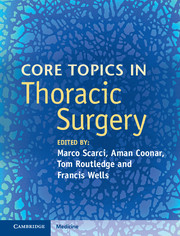Book contents
- Frontmatter
- Contents
- List of contributors
- Section I Diagnostic work-up of the thoracic surgery patient
- Section II Upper airway
- Section III Benign conditions of the lung
- Section IV Malignant conditions of the lung
- 11 Evaluation of solitary pulmonary nodule
- 12 Lung cancer staging
- 13 Pathological considerations in lung malignancy
- 14 Medical treatment of lung cancer (neo and adjuvant chemoradiotherapy)
- 15 Superior vena cava obstruction: etiology, clinical presentation and principles of treatment
- 16 Robotics in thoracic surgery
- 17 Pulmonary metastasectomy
- Section V Diseases of the pleura
- Section VI Diseases of the chest wall and diaphragm
- Section VII Disorders of the esophagus
- Section VIII Other topics
- Index
- References
14 - Medical treatment of lung cancer (neo and adjuvant chemoradiotherapy)
from Section IV - Malignant conditions of the lung
Published online by Cambridge University Press: 05 September 2016
- Frontmatter
- Contents
- List of contributors
- Section I Diagnostic work-up of the thoracic surgery patient
- Section II Upper airway
- Section III Benign conditions of the lung
- Section IV Malignant conditions of the lung
- 11 Evaluation of solitary pulmonary nodule
- 12 Lung cancer staging
- 13 Pathological considerations in lung malignancy
- 14 Medical treatment of lung cancer (neo and adjuvant chemoradiotherapy)
- 15 Superior vena cava obstruction: etiology, clinical presentation and principles of treatment
- 16 Robotics in thoracic surgery
- 17 Pulmonary metastasectomy
- Section V Diseases of the pleura
- Section VI Diseases of the chest wall and diaphragm
- Section VII Disorders of the esophagus
- Section VIII Other topics
- Index
- References
Summary
Adjuvant chemotherapy after surgical resection
Surgery remains the only curative treatment modality for patients with stage I–IIIA non-small cell lung cancer (NSCLC). However, even after complete resection, the risk of recurrence is substantial, and 5-year overall survival (OS) is approximately 70% for patients with stage IB disease, 40–50% for stage II and less than 30% for stage IIIA patients. Efforts to improve the survival of patients with operable NSCLC have examined the addition of chemotherapy (CMT) and/or radiotherapy (RT) in the post-operative setting.
In 1995, the NSCLC collaborative group reported a meta-analysis of eight trials with a total of 1394 patients treated with cisplatin-based adjuvant chemotherapy. This study reported a 13% reduction in the risk of death (hazard ratio [HR] 0.87; 95% confidence interval [CI]: 0.74–1.02) corresponding to an absolute survival benefit of 3% at 2 years (95% CI 0.5% detriment to 7% benefit) and 5% (95% CI 1% detriment to 10% benefit) at 5 years in favour of chemotherapy. Despite the lack of statistical significance (P = 0.08), these findings encouraged the initiation of several randomized trials investigating the role of platinum-based adjuvant chemotherapy in patients with completely resected stage I, II and IIIA NSCLC (Table 14.1).
The North American Intergroup Trial INT0115 was the only trial that compared the combination of chemotherapy plus thoracic radiotherapy versus radiotherapy alone in patients with completely resected stage II or IIIA NSCLC and failed to demonstrate a benefit in favour of chemotherapy. The negative results of the Adjuvant Lung Project Italy (ALPI) and the Big Lung Trial (BIG) further jeopardized the role of adjuvant chemotherapy in the treatment of NSCLC.
National Cancer Institute of Canada (NCIC) JBR10 trial
The National Cancer Institute of Canada (NCIC) JBR10 Trial randomly assigned 482 patients with completely resected, pathological stage IB and II (patients with T3N0 disease were excluded) to receive either post-operative adjuvant chemotherapy with cisplatin and vinorelbine or no chemotherapy.
At 5 years of follow-up, the 5-year survival rates were 69% for the chemotherapy arm and 54% for the control arm (HR 0.69; 95% CI 0.52–0.92; P = 0.011), with an absolute survival benefit of 15% for patients receiving chemotherapy.
- Type
- Chapter
- Information
- Core Topics in Thoracic Surgery , pp. 140 - 149Publisher: Cambridge University PressPrint publication year: 2016

